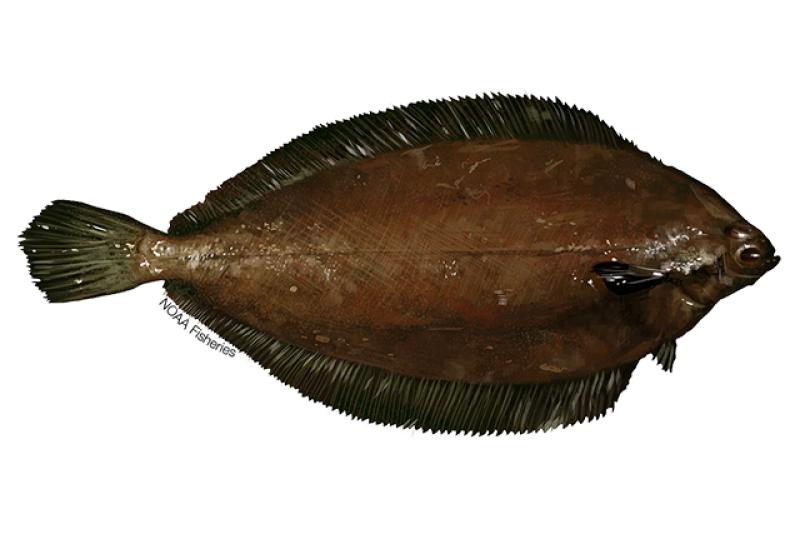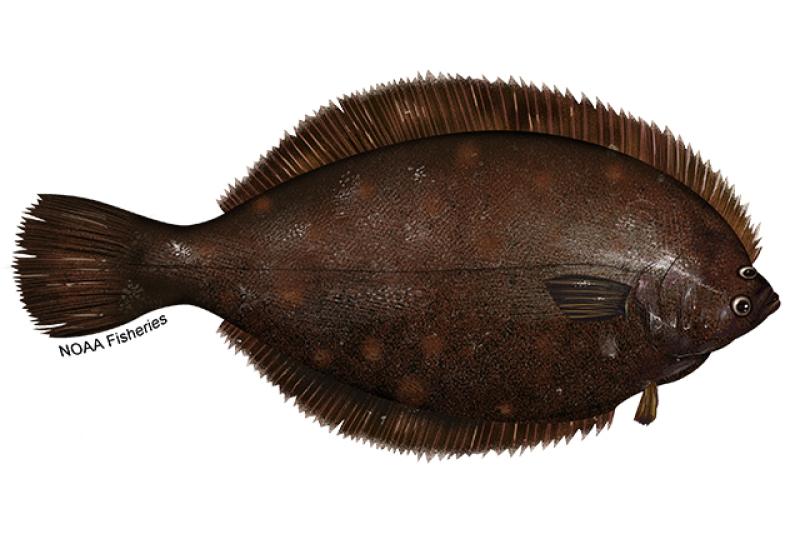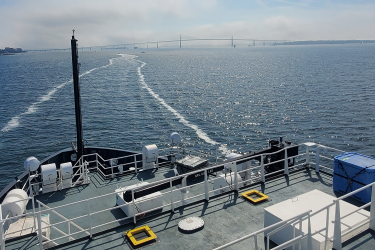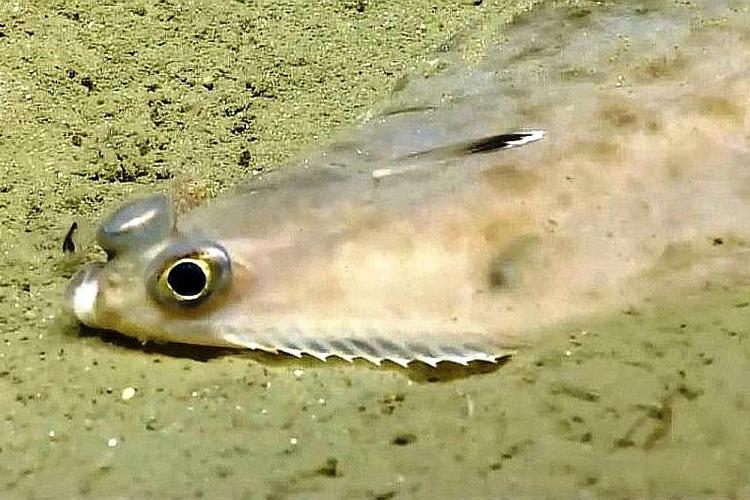 A witch flounder scoots across Atlantic Ocean bottom within Northeast Canyons and Seamounts Marine National Monument off New England. Credit: NOAA Okeanos Explorer 2013
A witch flounder scoots across Atlantic Ocean bottom within Northeast Canyons and Seamounts Marine National Monument off New England. Credit: NOAA Okeanos Explorer 2013
A witch flounder scoots across Atlantic Ocean bottom within Northeast Canyons and Seamounts Marine National Monument off New England. Credit: NOAA Okeanos Explorer 2013
About the Species
 A witch flounder scoots across Atlantic Ocean bottom within Northeast Canyons and Seamounts Marine National Monument off New England. Credit: NOAA Okeanos Explorer 2013
A witch flounder scoots across Atlantic Ocean bottom within Northeast Canyons and Seamounts Marine National Monument off New England. Credit: NOAA Okeanos Explorer 2013
A witch flounder scoots across Atlantic Ocean bottom within Northeast Canyons and Seamounts Marine National Monument off New England. Credit: NOAA Okeanos Explorer 2013
Relative to other flatfish in the region, witch flounder are a slow-growing, late-maturing, long-lived flatfish species found in the North Atlantic Ocean. It is a high-value groundfish species managed with other groundfish as part of the Northeast multispecies groundfish complex.

Population
The stock condition is poor. The stock is overfished and the catch advice has not resulted in population growth.

Fishing Rate
Overfishing status is unknown, but management measures are in place.

Habitat Impact
Area closures and gear restrictions protect habitats that are affected by some kinds of trawl gear.

Bycatch
Regulations are in place to minimize bycatch.
Population Status
Witch flounder is overfished, but the overfishing status is unknown (2022 stock assessment). Summary stock assessment information can be found on Stock SMART.
Appearance
Witch flounder is a right-eyed species of flounder. They have a relatively small head, small mouth, and narrow body. Witch flounder are covered in smooth scales. They have approximately 12 indentations on the underside (blind side) of their head. The top side (eyed side) of a witch flounder is generally grayish-brown in color, while the bottom side is white and covered with tiny dark dots. The top side pectoral fin is dusky or even black with a narrow light distal border.
Biology
Relative to other flatfish in the region, witch flounder are slow-growing, late-maturing, and long-lived. Witch flounder can grow up to 31 inches long. The median age at sexual maturity for male witch flounder is 4 years and 6.5 years for females. Female witch flounder are larger, heavier, and live longer than males.
Witch flounder typically spawn in cold water during March to November, with peak spawning occurring during the summer months. Witch flounder living near the northern end of the species’ range typically spawn later in the year than those living farther south. They spawn on or near the bottom of the ocean, and the fertilized eggs float and develop higher in the water column.
When witch flounder first hatch, their eyes are symmetrical, with an eye on each side of their head. As the fish grows, it flattens out and the left eye moves over to the right side of its head. After this metamorphosis, the juvenile settles to the ocean bottom. They do not complete metamorphosis until they are between 4 and 12 months old.
Adult witch flounder primarily feed on polychaete worms, but they also prey on other bottom-dwelling invertebrates such as sea cucumbers, small crustaceans, and small mollusks.
Where They Live
Range
Witch flounder are found on the eastern and western sides of the North Atlantic. Adult witch flounder are generally distributed along the edge of the continental shelf as far south as Cape Hatteras. Along the western side of the North Atlantic, witch flounder are distributed in deep, cold waters from Labrador to North Carolina.
No seasonal migration is known to occur.
Habitat
Witch flounder are found in deep waters in mud/silt, muddy-sand, and clay substrate. This may be the result of their food preference for polychaete worms.
Most commercial catches occur at depths of 90–275 meters over mud bottom at temperatures ranging from 2°C in winter to 9°C during summer.
Fishery Management
NOAA Fisheries and the New England Fishery Management Council manage the witch flounder fishery.
Witch flounder, along with other groundfish in New England waters, is managed under the Northeast Multispecies Fishery Management Plan, which includes:
- Permitting requirements for commercial vessels.
- Separate management measures for recreational vessels.
- Time/Area Closures to protect spawning fish and habitat.
- Minimum fish sizes to prevent harvest of juvenile fish.
- Annual catch limits, based on best available science.
- An optional sector (catch share) program can be used for witch flounder and other groundfish species. The sector program allows fishermen to form harvesting cooperatives and work together to decide when, where, and how they harvest fish.
Harvest
Commercial Fishery for Witch Flounder
In 2022, commercial landings of witch flounder totaled 1.7 million pounds, and were valued at almost $3 million, according to the NOAA Fisheries commercial fishing landings database.
Gear Types, Habitat Impacts, and Bycatch
Witch flounder are commonly harvested using trawl nets and, to a lesser extent, gillnets.
Areas closures and gear restrictions reduce habitat impacts from trawl nets. Fishermen follow management measures designed to reduce interactions with marine mammals, including gear modifications, seasonal closures, and use of marine mammal deterrents
Recreational Fishery for Witch Flounder
Witch flounder are not commonly encountered by the recreational fishery.
Recreational fishing regulations include a minimum fish size.
Scientific Classification
Witch flounder are found on the eastern and western sides of the North Atlantic. Adult witch flounder are generally distributed along the edge of the continental shelf as far south as Cape Hatteras. Along the western side of the North Atlantic, witch flounder are distributed in deep, cold waters from Labrador to North Carolina.
No seasonal migration is known to occur.
Witch flounder are found in deep waters in mud/silt, muddy-sand, and clay substrate. This may be the result of their food preference for polychaete worms.
Most commercial catches occur at depths of 90–275 meters over mud bottom at temperatures ranging from 2°C in winter to 9°C during summer.
Fishery Management
NOAA Fisheries and the New England Fishery Management Council manage the witch flounder fishery.
Witch flounder, along with other groundfish in New England waters, is managed under the Northeast Multispecies Fishery Management Plan, which includes:
- Permitting requirements for commercial vessels.
- Separate management measures for recreational vessels.
- Time/Area Closures to protect spawning fish and habitat.
- Minimum fish sizes to prevent harvest of juvenile fish.
- Annual catch limits, based on best available science.
- An optional sector (catch share) program can be used for witch flounder and other groundfish species. The sector program allows fishermen to form harvesting cooperatives and work together to decide when, where, and how they harvest fish.
Harvest
Commercial Fishery for Witch Flounder
In 2022, commercial landings of witch flounder totaled 1.7 million pounds, and were valued at almost $3 million, according to the NOAA Fisheries commercial fishing landings database.
Gear Types, Habitat Impacts, and Bycatch
Witch flounder are commonly harvested using trawl nets and, to a lesser extent, gillnets.
Areas closures and gear restrictions reduce habitat impacts from trawl nets. Fishermen follow management measures designed to reduce interactions with marine mammals, including gear modifications, seasonal closures, and use of marine mammal deterrents
Recreational Fishery for Witch Flounder
Witch flounder are not commonly encountered by the recreational fishery.
Recreational fishing regulations include a minimum fish size.
Scientific Classification
| Kingdom | Animalia | Phylum | Chordata | Class | Actinopterygii | Order | Pleuronectiformes | Family | Pleuronectidae | Genus | Glyptocephalus | Species | cynoglossus |
|---|
Last updated by NOAA Fisheries on 09/09/2024
Featured News
 The NOAA research vessel Gloria Michelle conducts groundfish surveys in New England, an important mission to support science-based fisheries management. Photo credit: NOAA Fisheries
The NOAA research vessel Gloria Michelle conducts groundfish surveys in New England, an important mission to support science-based fisheries management. Photo credit: NOAA Fisheries
As Fishing Season Opens, NOAA Implements Emergency Action to Ensure Uninterrupted Northeast Fisheries
 Juvenile coho salmon. Credit: iStock
Juvenile coho salmon. Credit: iStock
NOAA Fisheries Releases 2023 Status of Stocks
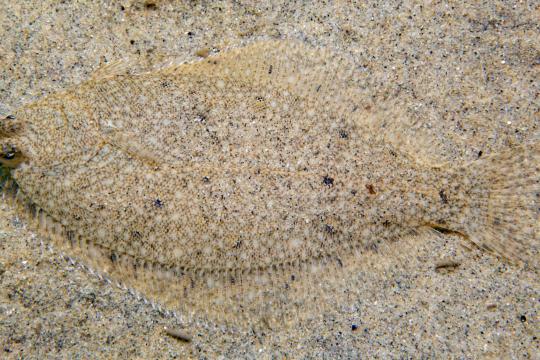
Scientific Trawl Gear Performance Better Understood Thanks to Collaborative Research

2019 Net Spread Study Targets Flatfish, Reveals Subtle Differences
Seafood Facts

U.S. wild-caught witch flounder is a smart seafood choice because it is sustainably managed and responsibly harvested under U.S. regulations.
Availability
Year-round.
Source
Wild-caught from Maine to North Carolina.
Taste
Subtle, sweet flavor.
Texture
Lean and flaky.
Color
Raw witch flounder ranges in color from white to pinkish to grayish brown. Cooked flounder is pure white.
Health Benefits
Witch flounder is a good low-fat source of B vitamins and niacin.
Nutrition Facts
Servings: 1; Serving Weight: 100 g (raw); Calories: 91; Protein: 18.84 g; Total Fat: 1.19 g; Total Saturated Fatty Acids: 0.283 g; Carbohydrate: 0 g; Total Sugars: 0 g; Total Dietary Fiber: 0 g; Cholesterol: 48 mg; Selenium: 32.7 mcg; Sodium: 81 mgMore Information
Last updated by NOAA Fisheries on 09/09/2024
Seafood News
 Celebrate Culinary Arts Month with a sustainable seafood recipe for every month of the year.
Celebrate Culinary Arts Month with a sustainable seafood recipe for every month of the year.
What Your Birth Month Says About Your Next Seafood Recipe
 Fresh-caught taʻape on ice. Credit: Conservation International Hawaiʻi.
Fresh-caught taʻape on ice. Credit: Conservation International Hawaiʻi.
Reducing Waste and Feeding Communities in Hawaiʻi with a Whole Fish Approach
 Chef Tyler Hadfield’s Curried Skate Wings with Tomato-Masala Chutney
Chef Tyler Hadfield’s Curried Skate Wings with Tomato-Masala Chutney
Ring In the New Year With These Crowd-Favorite Seafood Recipes
 NOAA Fisheries, in collaboration with Blue Ocean Mariculture, is conducting a multi-year pilot study to evaluate observational methods and tools for studying Hawaiian monk seal behavior. Courtesy of Blue Ocean Mariculture
NOAA Fisheries, in collaboration with Blue Ocean Mariculture, is conducting a multi-year pilot study to evaluate observational methods and tools for studying Hawaiian monk seal behavior. Courtesy of Blue Ocean Mariculture
AI Meets Aquaculture to Study Hawaiian Monk Seal Interactions With Net Pens
Management Overview
Witch flounder is managed under the Northeast Multispecies (Groundfish) Fishery Management Plan along with 12 other species of groundfish. Collectively, these 13 species are referred to as the Northeast multispecies complex.
Management Plans
More information about the Northeast Multispecies Fishery Management Plan from the New England Fisheries Management Council.
Regulatory History
- 1986: The Northeast Multispecies (Groundfish) Fishery Management Plan was implemented to reduce fishing mortality of heavily fished groundfish stocks and to promote rebuilding to sustainable biomass levels.
- 1977: USA Fishery Conservation and Management Act of 1976 went into effect.
- Early and mid 1970s: Closed areas to protect spawning haddock.
- 1953: The International Commission for the Northwest Atlantic Fisheries (predecessor of Northwest Atlantic Fisheries Organization) implemented minimum mesh regulations. [Since 1953 via series of amendments and framework adjustments, minimum mesh sizes and minimum fish sizes were adjusted and regulations controlled fishing effort (e.g., days at sea restrictions) and subsequently annual catch limits were implemented.]
More Information
Last updated by NOAA Fisheries on 09/09/2024
Science Overview
Every year, our Northeast Fisheries Science Center compiles valuable information from more than 600,000 species of fish, shark, and invertebrates collected by fishermen, scientists, and observers. This information gives scientists a detailed picture of the overall condition and health of northeast fisheries to ensure sustainable management.
For detailed information about stock status, management, assessments, and resource trends, you can search for witch flounder, and any other species of interest, using NOAA’s StockSMART web tool.
Last updated by NOAA Fisheries on 09/09/2024
Documents
More Information About Witch Flounder (Citations)
These citations were used to generate the information found on the witch flounder species page.
Last updated by NOAA Fisheries on 09/09/2024
